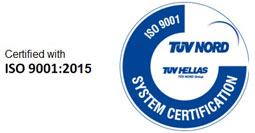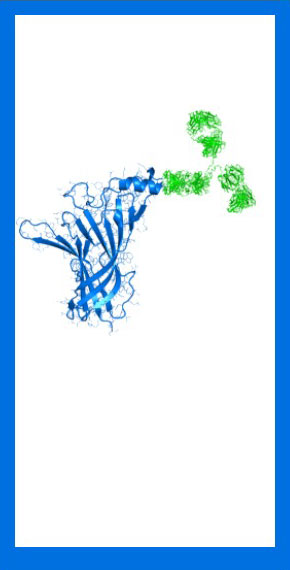MYASTHENIA GRAVIS (MG)
Antibodies against:
• Acetylcholine receptor (AChR) (by RIA).
In addition to the classical RIA, in the case of ambiguous result, the sample is also tested with our ~5-10X more sensitive RIA for further confirmation of the result
• MuSK (by RIA)
• Titin (by ELISA). Recommended to MG patients (usually positive for AChR antibodies) under 50 years of age, as an indication of the presence of thymoma.
• Ryanodine receptor (RyR)* (by blot). Recommended to MG patients (usually positive for AChR antibodies), as a further indication of the presence of thymoma
New tests for MG
These tests are recommended for those who are negative for AChR and MuSK antibodies by RIA and tend to eliminate the "seronegative" MG. However, false positive results cannot be excluded at this stage.
Antibodies against:
• LRΡ4 (by cell based assay, CBA). This is the 3rd antigen for MG, detected in ~9-19% of “seronegative” MG patients (according to Zhang, Tzartos et al. Arch Neurol, 2012. Zisimopoulou, Tzartos et al. J. Autoimm. 2013)
• MuSK (by live cell CBA). Detected in ~13% of the “seronegative” MG patients (according to Vincent et al. Ann. NYAS 2012 and Tsonis et al. J. Neuroimmunol. 2013).
• AChR clusters or "low affinity" AChR antibodies (by live CBA, according to Leite et al. Brain 2008). Testing for antibodies to AChR clusters is also recommended to confirm the presence of potentially pathogenic AChR antibodies (eg Maddison P. et al. J. Neuroimm. 2019 doi.org/10.1016/j.jneuroim.2019.04.0).
• Agrin* (by immunofluorescence). Agrin is secreted from the nerve terminal and binds to and activates LRP4 which in turn binds to and activates MuSK. Some MG patients without or with AChR antibodies have anti-Agrin antibodies.
MYASTHENIC SYNDROME LAMBERT-EATON (LEMS)
AUTOIMMUNE DYSAUTONOMIA
• Antibodies against ganglionic α3 AChR by RIA (not very specific at low titers) or by CBA (our new method, very specific for autoimmune dysautonomia; Karagiorgou et al., Neurol, Neuroimmunol & Neuroinfl. 2022;9:e1162. doi:10.1212/NXI.0000000000001162)
MYOSITIS (Polymyositis / Dermatomyositis) (by blot)
• Antibodies against Mi-2α, Mi-2β, Ku, PM-Scl100, PM-Scl75, SRP, Jo-1, PL-7, Pl-12, OJ, EJ, Ro-52, ΤΙF1γ, MDA5, NXP2, SAE1
Necrotizing Myositis
Inclusion Body Myositis
PERIPHERAL NEUROPATHIES
• Antibodies against gangliosides GM1, GM2, GM3, GM4, GD1a, GD1b, GD2, GD3, GT1, GT2, GQ1b, Sulfatide (by dot blot)
• Antibodies against SGPG and the protein MAG (myelin associated glycoprotein) (ELISA)
• Antibody screening for CIDP-type peripheral neuropathies:
NEUROMYELITIS OPTICA (NMO) or Devic’s disease
Antibodies against:
• Aquaporin-4 (AQP4) (by CBA and quantitative RIA)
• Myelin oligodendrocyte glycoprotein (MOG) (by live CBA)
• Aquaporin-1 (AQP1, according to Tzartos et al. PlosOne, 2013) (by ELISA)
• Detection of the protein GFAP in CSF during relapse (by ELISA)
Autoimmune Meningoencephalomyelitis
MULTIPLE SCLEROSIS
• Detection of oligoclonal IgG bands in serum and CSF
• Determination of albumin and IgG concentration in serum and CSF
PARANEOPLASTIC SYNDROMES
• Paraneo-1: Antibodies against: Hu (ANNA-1), Ri (ANNA-2), Yo (PCA-1), PNMA2 (Ma2/Ta), CV2 (CRMP-5), amphiphysin, recoverin, SOX1 (AGNA), zic4, Tr(DNER), GAD, Titin (by blot and immunofluorescence in tissue)
• Paraneo-2: Antibodies against ITPR1 (Inositol 1,4,5-trisphosphate receptor 1, I3PR) and CARP VIII (Carbonic anhydrase-related protein VIII) and TR(DNER) (by CBA)
• Kelch-like protein 11 (Kelch-11 or KLHL11) (by CBA)
Autoimmune Encephalitis-1 (AE1):
• Caspr2 and LGI1 (proteins associated with potassium channels) (by CBA)
• NMDAR, AMPAR1- AMPAR2, GABABR (by CBA)
MOG, DPPX (by CBA)
Autoimmune Encephalitis-2 (AE2):
• The above 8 antigens (AE-1), and
• Glycine Receptor (by CBA)
• mGluR5
• GAD65 (glutamic acid decarboxylase-65) (by ELISA)
Optionally, 11 additional tests for AE:
• Kelch-like protein 11 (Kelch-11 or KLHL11) (by CBA)
• Potassium channels (VGKC. Kv1.1, 1.2, 1.6) (by RIA)
• GABAAR, mGluR1, Iglon5 (by CBA)
The specificity and pathological significance of the following are under investigation:
• Dopamine-2 receptor (DR) (by CBA)
• Neurexin-3α (by CBA)
• Homer-3*
• GluRδ2*
• Neurochondrin*
Antibody test packages for syndromes related to autoimmune encephalitis:
Limbic and NMDA encephalitis
• Autoimmune Encephalitis-1 (AE1)
• mGLuR5 (by CBA)
• GAD65 (by ELISA)
• Paraneo-1
• Paraneo-2
• Kelch-11 (by CBA)
• mGluR1 (by CBA)
• GAD65 (by ELISA)
• VGCC-P/Q (by RIA)
• Autoimmune Encephalitis-1 (AE1)
• Paraneo-1
• GAD65 (by ELISA)
• Paraneo-1
• CASPR2, LGI1, NMDAR, AMPAR1,2, GABAΒR, DPPX
• CASPR2, LGI1, NMDAR (by CBA)
Hypothalamic dysfunction
• Paraneo-1 (only Ma2)
• CASPR2, LGI1(by CBA)
• AQP4 (by CBA and RIA)
Vision disorders of autoimmune etiology
• AQP4 (by CBA and RIA)
• MOG (by CBA)
• Paraneo-1 (only CRMP-5/CV2 and recoverin. Optionally: Hu, Yo,Ma2, Ri,Tr)
Stiff-Person Syndrome / PERM
• Paraneo-1 (only Amphiphysin)
• Glycine Receptor (by CBA)
• GAD65 (by ELISA)
Autoimmune Chorea
• Paraneo-1 (only Hu,CV2)
Opsoclonus & Myoclonus
• Paraneo-1 (only Ri, Hu)
Brainstem syndrome
• Paraneo-1 (only CRMP-5, PCA-2, Hu, Ri, amphiphysin, Ma2)
• AQP4 (by CBA and RIA)
• Kelch-11 (by CBA)
Autoimmune myelopathy
• AQP4, MOG
Sensorimotor neuropathy
CREUTZFELDT-JACOB
• Detection in the CSF.of the proteins 14-3-3 (by ELISA), total Tau and phospho-Tau (181-p) (in <24 hours by chemiluminescence)
ALZHEIMER
• Detection, in CSF, of the proteins: beta-amyloid(1-42) and (1-40), total Tau and phospho-Tau(181-p), (in <24 hours by chemiluminescence)
• Detection in the plasma: pTau181 and NFL with SIMOA technology.
GENETIC TESTS
• Mutations in TPMT (predict hypersensitivity to thiopurines, such as Azathioprine)
• Clinical Exome Sequencing and Whole Exome Sequencing for neurological diseases (performed by a collaborating laboratory)*
RESEARCH
In addition to our own research for the development of new diagnostics, we also welcome participation in research protocols in collaboration with interested clinicians.
 English
English  Greek
Greek 
